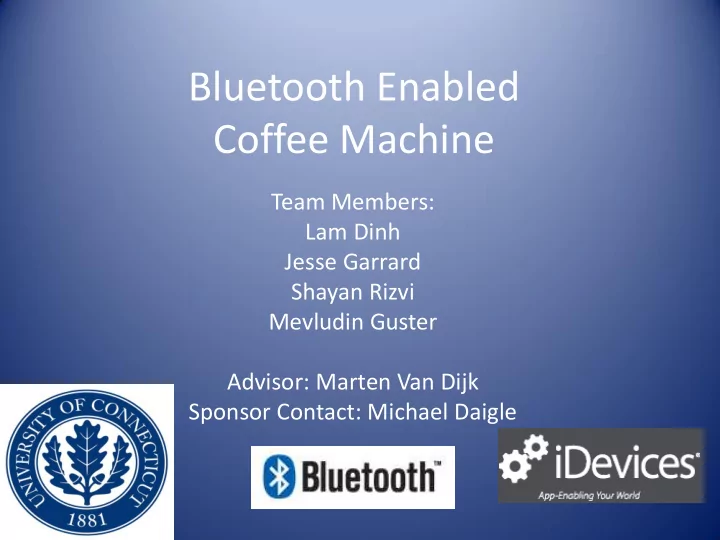

Bluetooth Enabled Coffee Machine Team Members: Lam Dinh Jesse Garrard Shayan Rizvi Mevludin Guster Advisor: Marten Van Dijk Sponsor Contact: Michael Daigle
Who are we? Team Members: • Jesse Garrard • Lam Dinh • Shayan Rizvi • Mevludin Guster Advisor: Marten Van Dijk Sponsor Contact: Michael Daigle
Outline • iDevices • Our Project • Keurig Coffee Maker • Hardware and Microcontroller • Servo Motor • Android Application
iDevices • Founded in 2010 • Located in Avon, CT • “Leaders in the development of app -enabled products and processes”. • Develops app-enabled products both independently and with partner companies.
Our Project • To Bluetooth-enable a coffee machine that will allow users the convenience of operating the machine from any location in its vicinity. • Keurig Coffee Maker • Electronic components – AVR Microcontroller – Broadcom Bluetooth Module – Servo motor • Android App
Keurig Coffee Maker (B40) • 4 PCBs – Power conditioning and fuse board – Main Board: AVR Microcontroller – Heat control/filtering and power distribution – Button Interface Board
Hardware Components • Take apart a Coffee maker LCD indicator Voltage Conversion circuit Microcontroller Wires for heating elemen t
Design Flowchart Servo Motor App Bluetooth Relay module Infrared sensor
Microcontroller and Bluetooth Module • Atmega 328 – Operating Voltage: Vcc=5V – 32 Kb Flash memory – 23 GPIO, 10bit-ADC • Bluetooth Module (Broadcom) – Operating Voltage: Vcc=3.3V – Operating range: 50-75ft – Send and receive with AVR via serial communication
Servo Motors • Used in robotics, toy cars, airplanes, etc. • It has circuitry built in the motor unit and has a position able shaft which is fitted with a gear. • The motor of the servo is controlled with an electric signal which ends up determining the movement of the shaft • Made up of a small DC Motor, potentiometer and a control circuit
Servo Motors (Continued) • Servo Motors turn 90 degrees in either direction resulting in 180 degrees of total movement • Servo’s run on proportional control – this means the motors speed proportional to the difference in the servo’s position from its desired position. So it will move at a slower rate if it is closer to the desired position. This is a very efficient model. • There are two types of Servo motors – AC and DC • AC Servo’s handle higher currents and are designed for industrial machinery • DC Servo’s handle smaller currents and are used for smaller applications, this goes to show that we will be applying a DC Servo motor
Servo Application w/Keurig • The goal is to expand the idea of the coffee maker • Allowing the user to select the brand of coffee they want to have brewed at a specific time from the smart phone application • Integrating the Servo motor with the Keurig coffee maker so it can apply the proportional control to rotate the different K-cups within the Keurig
Software • Java • Communication via Bluetooth(API 5) • Minimum Froyo(2.2)(API 8) • Current Jelly Bean(4.3) • Basic Layout • User friendly
Android Application • Set time to brew • Coffee ready push notification • Water level • Cup size (8oz, 10oz, 12oz) • Flavor • Stop/Cancel Brew
When Will This Work Occur?
Budget • Prototyping Cost < $1000 • Final Product Cost < $300
Demo • ATmega328P Microcontroller • RN42 Bluetooth Module
QUESTIONS?
Recommend
More recommend